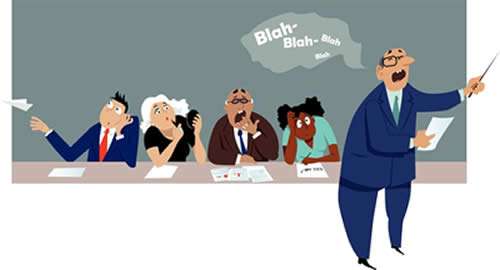You're halfway through an important
presentation. Your boss and key clients are in the front row. The early jitters have subsided, and you feel like you're getting into the flow. It's time to really impress this crowd, and win that vital project funding/contract/professional respect.
Then, just as you're getting comfortable on the stage, it hits you. This isn't going well at all. People are looking at their phones, or around the room. Nobody is keen to make eye contact with you. In fact, you're on your way to completely losing your audience.
You spent a lot of time planning and rehearsing this presentation. So, where did it all go wrong? Is there still time to save your reputation – and do better next time?
The answer is yes – and yes. Here are 7 key reasons that presentation audiences lose interest, and the solutions you need to win them back. Recognise these signs and apply our simple fixes, and you can rescue your presentations from snoozeville and avoid boring your audience.

1. You're talking too fast
The problem: It's natural to be nervous before and even during a big presentation. But you must get your nerves under control if you want project confidence and engage the audience.
If you don't, your nerves will show in your performance. You might talk too fast, trip over your words, appear nervous, or forget what you planned to say. All these things could make your audience lose trust in you, and switch off from what you're saying.
The solution: Get the better of your public speaking nerves by recognising them, preparing your presentation thoroughly, and rehearsing your performance. With your nerves under control, your personality will shine through and your audience will be more engaged.
2. There's too much on your slides
The problem: Excessive use of PowerPoint slides is a well-known presentation killer. Too many slides with too much text is a real turn-off. When your audience sees a wall of text, they quickly realise there is far too much information for them to take in. Then they stop listening.
The solution: Follow the rule that a slide "should be a billboard, not a document". In other words, a slide should:
- Feature only 1-3 lines of text.
- Make use of engaging visual imagery where possible.
- Include only the key takeaways for your audience. There's no point adding a lot of detail, because nobody will remember it!
With simple, uncluttered, visually appealing slides providing context, your audience will be able to follow your presentation more easily.
3. Your content isn't useful to the audience
The problem: Giving a presentation to an audience is a privilege. The audience, which might include your clients, colleagues, and superiors, have given you their valuable time and attention. They will be bored (and disappointed) if you don't give them something useful in return.
There are several reasons your content might be boring rather than useful. These include:
- Lack of preparation. No matter how great your expertise, it takes time and hard work to write a useful presentation. Your audience will know if you try to wing it.
- Not meeting the audience's needs. Your topic needs to help solve a problem your audience has. If your content isn't relevant, why should they listen?
- Not matching the audience's knowledge level. Different crowds have different levels of education and knowledge. If you go too high brow or dumb things down, you'll lose them.
- It's old news. If the audience feels they've heard it all before, they're bound to switch off.
The solution: Make sure you know who is in your audience. What do they need? What do they already know? What kind of language will engage them? Consider all these factors when designing your presentation, and they'll be hanging on your every word.

If you'd like to learn more about delivering presentations, why not take a look at how we can help?
Boost your presentation skills with our online courses.
RRP from $65 – limited time offer just
$23.99
4. There's too much jargon
The problem: It doesn't matter what level your audience is at. If your presentation is full of jargon, technical talk, and strange acronyms, it will be hard to follow. Even if your audience is full of experts, they will still have different specialisations. For example, in a room full of programmers, some might know about web development while others know about object-oriented programming. If you assume everyone has the same knowledge as you, you will lose half of them.
The solution: Use simple language where possible, to make sure everyone understands your topic. Take special care to communicate your key points in simple terms that are easy to understand. Make sure you explain any specialist terms and concepts you introduce, using slides where possible.
5. It's too long
The problem: As public speaking expert Stephen Keague put it, "No audience ever complained about a presentation or speech being too short." On the other hand, plenty have complained about presentations being too long! Presentations start to feel long when they:
- Repeat the same information over and over.
- Labour a point the audience already understands.
- Go off on tangents that aren't useful.
The solution: Respect your audience. As we mentioned above, they have given you their time and you must repay them with useful information. Keep your presentation short, to the point, and free of waffle. It will be much better for it.

6. It's dull and drab
The problem: It's essential that your content is useful and relevant. But your audience aren't robots – and you shouldn't come across as one either. If your talk is too dry, technical, or complicated, they'll start daydreaming.
The solution: Your presentation needs personality and lighter moments. Consider using:
- Humour and jokes, especially in the opening and conclusion of your presentation when the audience is most receptive.
- Multimedia content like pictures, video and slides, which can make things more dynamic and interesting.
- A personal touch, such as sharing your own relevant experiences and difficulties.
The more personality and colour you put in, the better you can engage your audience.
7. The audience doesn't trust you
The problem: Finally, remember that people won't listen to you if they don't trust you. Often, audience members will be meeting you for the first time. If they don't see a reason to trust your expertise, they may switch off.
The solution: Use the first few minutes of your presentation to establish your credibility and likeability. Let the audience know:
- Who you are.
- Your general level of education and professional experience, if helpful.
- What makes you an expert in the topic at hand.
- If you can make a good impression with your charm and humour, even better. But the most important thing is to show that you are worth listening to.
Get into a new groove
It doesn't matter whether you're new to presenting, or an old hand. Inexperience and over-familiarity can both lead to weak presentations. With these 7 new methods in your toolkit, you can overhaul your approach and deliver more successful talks.
Go knock ‘em dead!

If you'd like to learn more about delivering presentations, why not take a look at how we can help?
Boost your presentation skills with our online courses.
RRP from $65 – limited time offer just
$23.99




























